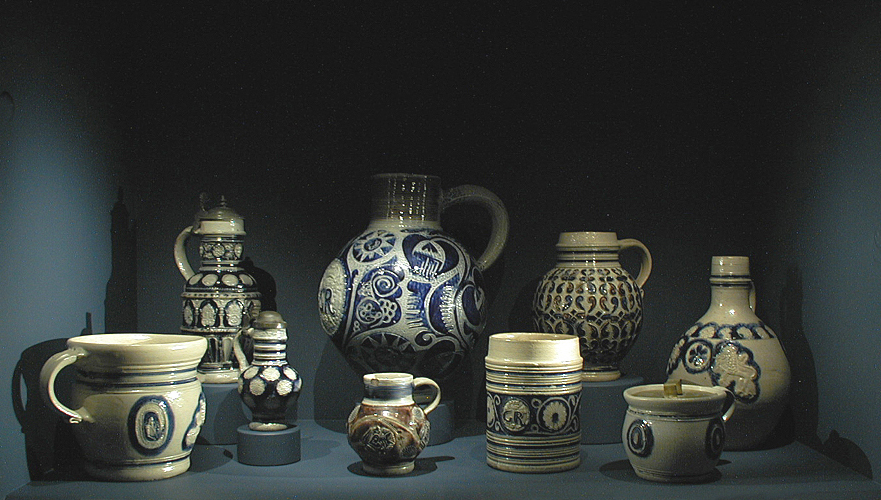
Showing the possibility and fitness of uniting the
best class of design with the cheapest
material and in objects of constant popular use.
One of several reasons cited in 1868 for the Victoria and Albert Museum purchasing
German stoneware.
Both brown and blue-on-gray stonewares from the Rhineland were in general
use in England and her American colonies by the early seventeenth century
and would continue to be imported as late as 1776. These were decorated with cobalt (blue) and
sometimes manganese (purple). Such wares, first imported from Raeren and then
from the Westerwald district, became a staple of British households and taverns—in
spite of growing competition from English stoneware potters from the 1680s
onward.
The lidded drinking vessel (1) is dated 1585, and the chamber pot (2) is dated
1632—the earliest example of the form yet recorded. The large ale jug
(6) and the tavern mug (7), decorated with the ciphers of George I and George
II, are typical of the German export trade in the first half of the eighteenth
century. The small chamber pot (9), with its original brass lid, was unearthed
in Amsterdam. It is the smallest Rhenish example the Noël Humes had seen
and may be the smallest known.
1. Drinking vessel, stoneware. Raeren or Westerwald,
Germany, dated 1585 (or 1587).
2. Chamber pot, stoneware. Westerwald, Germany, dated
1632.
3. Quatern or gill measure, stoneware. Westerwald,
Germany, ca. 1630–1660.
4. Mug or gorge, stoneware. Westerwald, Germany, ca.
1680–1700.
5. Jug, stoneware. Westerwald, Germany, ca. 1680–1700.
6. Jug, stoneware. Marked GR (George Rex, or King George).
Westerwald, Germany, ca. 1725–1750.
7. Mug, stoneware. Marked GR. Westerwald, Germany,
ca. 1714–1740.
8. Bottle, stoneware. Westerwald, Germany, ca. 1710–1760.
9. Chamber pot with original brass lid, stoneware.
Westerwald, Germany, ca. 1750

